(Editor’s note: Pat and I are very grateful to Dr. Bruce Cattanach
for giving us the opportunity to publish the account of his creation of the bob-tailed
boxer, and to Elaine Whitehill, his co-worker, for the photo scans that accompany
this article. Most of the following information about Dr. Cattanach’s bob-tails was
taken from the August 28, 1998 British DOG WORLD.)
UNDERGROUND
NEWS FLASH!!!
REINVENTING THE BOXER:
The
Fantastic Account of
Dr Bruce Cattanach’s
Bobtail Boxers
by
Virginia Zurflieh
You know the old
saying - everybody talks about the weather, but nobody does anything about it. Earlier
this year, there was a storm brewing in the boxer fancies of both Europe and America with
the imminent prospect of a law against tail-docking in Germany and England and a vote to
allow uncropped boxers in the showring without penalty in the U.S. (which some fanciers
believed would lead to a ban here on both cropping and docking). Everybody in boxers was
talking about the supposed esthetic and health benefits (or not) of cropped ears and
docked tails, and how awful it would be if we had to look at long-tailed boxers in the
ring, nevermind live with them. Several fanciers even said they'd switch to another breed
before they'd try to get used to a boxer with a tail.
Then Dr. Bruce
Cattanach did something about it: he reinvented the boxer...with a naturally docked tail!
What’s more, the Kennel Club in England (equivalent to our AKC) has just accepted the
fourth generation of Dr. Cattanach’s bob-tails for registration, AS PUREBRED BOXERS!!
The
"Reinventor’s" Qualifications
Dr. Cattanach is
uniquely qualified to carry out this experiment. He has been a noted breeder/exhibitor of
boxers in England since 1949 under the Steynmere prefix, and is a geneticist by
profession, with a specialty in the cause and analysis of genetic defects. Until his
recent "semi-retirement," Dr. C. was Director of the Medical Research Council
Mammalian Genetics Unit in the UK. He also worked in the USA in the 1960s, and in fact,
took a Cherokee Oaks bitch back to the UK to found his current Steynmere breeding program
when he returned to England in 1969. Dr. C. was instrumental in eradicating the crippling,
hereditary, neurological disease, Progressive Axonopathy, from the British boxer in the
1980s, and is currently working to lessen the very widespread incidence of SAS in British
bloodlines. Before embarking on the bob-tail experiment, Dr. Cattanach informed the
(British) Kennel Club of his plans well in advance, kept detailed records, and backed up
his research with DNA analysis of all the participants. Since the KC, like the AKC, is a
very conservative organization, it was doubtless Dr. C.’s pre-planning, scientific
methods, and detailed records that led to their acceptance of the fourth generation of his
bob-tails for registration as purebred boxers.
The
Reinvention Process
Below, in
chronological order, is a photographic record of the ongoing results of the bob-tail
experiment started by Dr. Cattanach in 1992 in anticipation of a docking ban in Britain,
where ear-cropping has already been forbidden for many years. According to the summary at
the top of page 4 in the August 28, 1998 Dog World, "A principal objective was to see
if, through a series of backcrosses [to purebred boxers], the Corgi bob-tail gene could be
transferred into the Boxer."
The experiment began
with the crossing of one of Dr. Cattanach’s boxer bitches to a Pembroke Corgi with a
dominently inherited bob-tail, Vaquera of Pemwell. Neither the boxer foundation
bitch nor the corgi are pictured here.
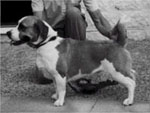
|
Figure 1: one of two first generation bitches used for breeding,
"Dolly," was the result of the original boxer/corgi cross. Dr. Cattanach noted
that all the first generation pups were corgi-like in build. |
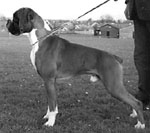
|
Figure 2: the purebred boxer, Steynmere Foreign Service, that was mated to
Dolly to produce... |
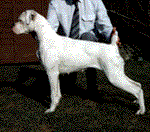
|
Figure 3: the second generation crossbred, "Jane." Clearly,
Jane, though white, looks like a boxer, with long legs, a short coat, and a natural
bob-tail! |
| Figures 4a, 4b,
& 4c: the third generation, at ten months. Since Jane was white and lacking in head,
Dr. Cattanach bred her to a male that was very typey and completely plain, Boxella’s
Chief at Zenmaxkay - of Dutch/German breeding - to produce... |
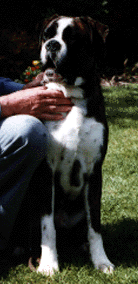
|
Figure 4a: "Big brindle male, George, with excellent head
and mouth, and precision front. A bob-tailed dog of show quality." |
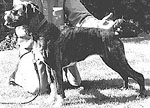
|
Figure 4b: "Paddy," a "pretty good brindle bitch with a
longer, blunt ended bob-tail with a single kink." |
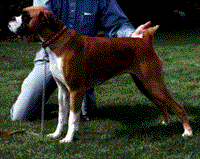
|
Figure 4c: "Bobby," a fawn bitch with a typical bob-tail. |
| Figures 5a &
5b: the fourth generation, both by Santonoaks Red Hot Prospect for Mylicam, a purebred
boxer, x the third generation bitch, Bobby. |
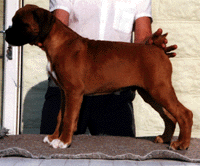
|
Figure 5a: plain fawn male - "over-typical"! |
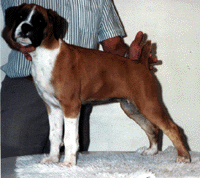
|
Figure 5b: flashy fawn bitch, lacking in stop, but a better head than her
dam, Bobby. |
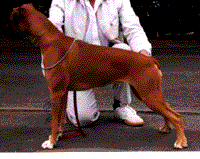 |
Figure 6: another fourth generation fawn bitch by third generation,George,
x purebred boxer, Steynmere Set the Fashion. Pictured at eight months. Unfortunately, not
bob-tailed, but docked. After KC acceptance and registration, this puppy was exhibited at
a Midland Boxer Club show, and although she didn’t place (there were 20+ 6-9 puppies
in her class), "...no one noted anything atypical about her appearance or
temperament. She performed in the ring without special attention other than from those in
the know. It will be nice if the bob-tail puppies from the recent litters can finish up
looking as good" according to Dr. Cattanach. |
The Present
In Dr.
Cattanach’s own words, "...Boxer type is now essentially established and so the
final task will be to develop the show potential. I do not expect this to be any harder
than with purebred Boxers. The unique Boxer head seems to be the major problem but then,
in my experience, this is also the case within the breed."
"In conclusion,
although these puppies may not fulfil everyone’s idea of show quality Boxers, I think
it is fair to claim that the original primary objectives of the project have been
achieved: a gene has been successfully transferred from one breed to another, and I have
my bob-tail Boxers which do not need to be docked."
The Future
Again in Dr.
Cattanach’s own words, "The final step takes us back to genetics. What will
happen when bob-tails are intercrossed? As indicated above, I hope to conduct at least one
such intercross, but in reality, the answer must come from the bob-tail Corgi or Vallhund
breeds in which bob-tailed animals are regularly intercrossed."
Until I am certain
that there are no ill effects associated with the bob-tail gene in double dose, I will
keep control of all the registrations. For the present, every animal I have sold,
bob-tailed or otherwise, has either remained registered in my name, or has had its KC
registration endorsed ‘Progeny not eligible for registration.'"
"As to the
other possibility of introducing the erect ear gene into the boxer from the Corgi as
originally contemplated, I’m afraid this option is no longer available. I have
attempted to mate the one bitch retained for the purpose on several occasions but she has
always appeared past time when her owners have notified me. Only if the Boxer Breed
Council were to be interested in developing erect-eared Boxers would I contemplate
starting such a project again." |
